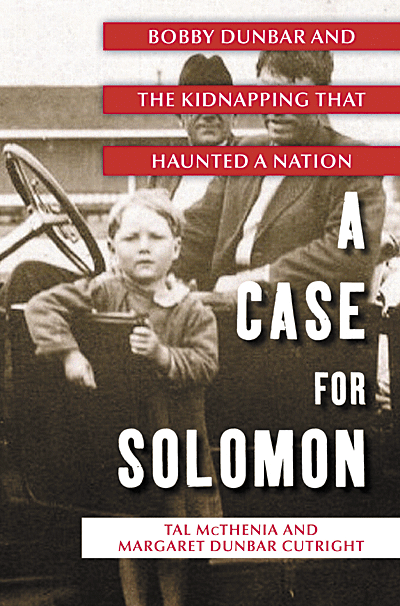BY ALLEN G. BREED
Associated Press
A CASE FOR SOLOMON: BOBBY DUNBAR AND
THE KIDNAPPING THAT HAUNTED A NATION
By Tal McThenia and Margaret Dunbar Cutright
Free Press
In the foreword of “A Case for Solomon,” Margaret Dunbar Cutright declares that in choosing to share this story, “I had hurled open the family closet and was yanking out its skeletons. I was betraying, and dividing, my own family.”
From the outset, she and co-author Tal McThenia telegraph the conclusion of this nonfiction legal thriller. Even so, the story is so fraught with, as McThenia puts it, “incredulous questions,” the reader is compelled to forge ahead, in the vain hope that the main characters will somehow come to their senses.
The book details the Aug. 23, 1912, disappearance of 4-year-old Bobby Dunbar in Opelousas, La. Cutright first heard the story in the fifth grade of how her grandfather had vanished during a family outing, and how he was recovered eight months later in Mississippi in the company of William Cantwell Walters, a roving “tinker” from North Carolina.
The case was a national sensation — the subject of newsreels, songs and even a vaudeville play. When the son of famed aviator Charles Lindbergh was kidnapped in 1932, reporters came knocking on Robert Dunbar’s door for comment.
Growing up, Cutright — whose father was Robert Dunbar Jr. — had no reason to question the story. It wasn’t until her brother died and she inherited a family scrapbook filled with newspaper clippings about the case that she began to have doubts.
As she dug deeper into the story, Cutright located the defense file from Walters’ trial, bulging with telegrams, affidavits and letters. A slew of witnesses had placed Walters and the boy miles away in Mississippi at the time of Bobby’s disappearance. Walters had steadfastly maintained that the boy with whom he was traveling was Bruce Anderson, the son of a woman who worked for his family back in North Carolina — not the missing son of Percy and Lessie Dunbar.
At the time, Bruce’s mother, Julia Anderson, was portrayed by much of the press as a loose woman. She was vilified when she didn’t recognize her son when they were first reunited — although Lessie Dunbar also could not at first swear that the found boy was Bobby.
Most newspapers and the court sided with the “respectable,” middle-class Dunbars.
In their book, McThenia and Cutright do much to rehabilitate Julia Anderson, and to illustrate just how thin the veneer of respectability can be. Their research is exhaustive. You can feel the pull of the boot-sucking mud of the swamp where Bobby disappeared, sense the damp of Walters’ cell at the St. Landry Parish Jail, smell the sweat and cigar smoke of the packed courtroom. If anything, the detail is sometimes almost too much.
The book’s subtitle — “Bobby Dunbar and the Kidnapping that Haunted a Nation” — suggests that a crime was indeed committed back in 1912. But was Bobby — or Bruce — the real kidnap victim?
Thanks to DNA testing, we get a definitive answer. But, as McThenia suggests, that answer “in this story, for this boy, is not so clear-cut.”
“This is a story of loss: one mother’s agonizing surrender to it, and another mother’s terrified, scorched-earth fight against it,” he writes. “It is a story of the ferocious, selfless, and seemingly irrational maternal instinct to protect a child.”
Copy the Story LinkSend questions/comments to the editors.



Success. Please wait for the page to reload. If the page does not reload within 5 seconds, please refresh the page.
Enter your email and password to access comments.
Hi, to comment on stories you must . This profile is in addition to your subscription and website login.
Already have a commenting profile? .
Invalid username/password.
Please check your email to confirm and complete your registration.
Only subscribers are eligible to post comments. Please subscribe or login first for digital access. Here’s why.
Use the form below to reset your password. When you've submitted your account email, we will send an email with a reset code.